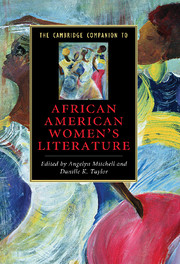Book contents
- Frontmatter
- Introduction
- Part 1 History, contexts, and criticism
- Part II Genre, gender, and race
- 6 African American women and the United States slave narrative
- 7 Autobiography and African American women’s literature
- 8 “Even some fiction might be useful”: African American women novelists
- 9 African American women poets and the power of the word
- 10 African American women in the performing arts
- 11 African American women writers of children’s and young adult literature
- 12 African American women essayists
- 13 African American women writers and the short story
- 14 African American women writers and popular fiction: theorizing black womanhood
- Bibliography
- Index
13 - African American women writers and the short story
from Part II - Genre, gender, and race
Published online by Cambridge University Press: 28 July 2009
- Frontmatter
- Introduction
- Part 1 History, contexts, and criticism
- Part II Genre, gender, and race
- 6 African American women and the United States slave narrative
- 7 Autobiography and African American women’s literature
- 8 “Even some fiction might be useful”: African American women novelists
- 9 African American women poets and the power of the word
- 10 African American women in the performing arts
- 11 African American women writers of children’s and young adult literature
- 12 African American women essayists
- 13 African American women writers and the short story
- 14 African American women writers and popular fiction: theorizing black womanhood
- Bibliography
- Index
Summary
The year of John Brown's unsuccessful uprising at Harpers Ferry, writer, lecturer, and political activist Frances Ellen Watkins Harper launched African Americans' participation in the art of short story writing. Harper's short story “The Two Offers” (1859) appeared in the Anglo-African, a magazine published in New York from 1859 to 1865 by Thomas and Robert Hamilton with a view to educate, encourage, and provide a voice for black people in America. Emblematic of the work of racial uplift, the tale traces the lives of two young cousins, Laura Lagrange and Janette Alston, and the consequences of the one young woman's decision to pursue romantic love and marriage and the other's attempt to discover the full scope of her abilities and inner self. For Harper and African American writers who followed her, the short story provided a vehicle through which they could explore the complex realities of African Americans' lived experiences in a form shorter than that of the novel. As an African American woman writer, Harper opened a way for other black women to explore the tension between women's self-fulfillment and adherence to social convention implicit in Anglo-America's cult of true womanhood. There are those nineteenth- and twentieth-century African American women short story writers, like Harper, Pauline Hopkins, Zora Neale Hurston, Alice Walker, and Toni Morrison, who are perhaps better known for their accomplishments as novelists, poets, and essayists. Because of its accessibility, the short story invites innovation, an opportunity to experiment with style and form, voice and language. An exploration of the short story reveals black women's significant contributions to the aesthetic and political contours of the form over time.
- Type
- Chapter
- Information
- The Cambridge Companion to African American Women's Literature , pp. 245 - 261Publisher: Cambridge University PressPrint publication year: 2009



